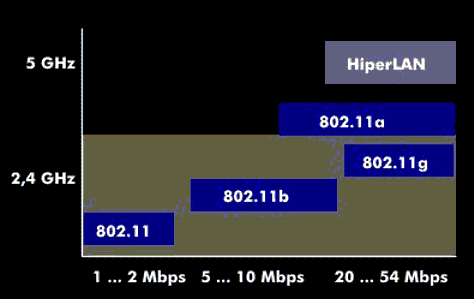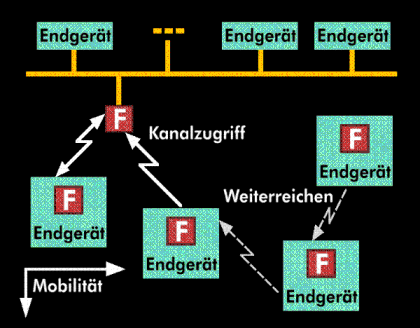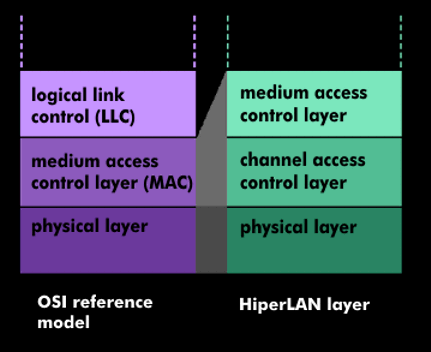high performance radio local area network (HiperLAN)
The specifications for HiperLAN were developed by the European Telecommunications Standards Institute(ETSI), Working Group RES10. HiperLAN/1 is the first standard of the ETSI BRAN project for radio broadband access networks. HiperLAN/1 supports high-speed communications with transmission rates of 20 Mbit/s between portable devices. As a radio frequency range, HiperLAN/1 uses the 5 GHz frequency range
The HiperLAN standard
The HiperLAN standard covers broadband transmission for wireless local area networks(WLANs) and is based on existing LAN concepts with ATM and IP protocols.
For this reason, HiperLAN is limited to standardizing the physical layer and the MAC layer and retains the standardized interface to the LLC layer. The MAC layer is divided into a so-called medium access control sublayer and a channel access sublayer, the latter defining the channel access procedure.
Since other transmission modalities play a role in WLANs in contrast to wired LANs, these must be handled in the MAC layer. These include address mapping, in which the internal address structures of the HiperLAN standard are converted from the MAC address to the HiperLAN address by means of address mapping. Furthermore, the encryption algorithm with corresponding key management, the forwarding of data packets across several stations and the data transmission of time-critical as well as asynchronous, time-uncritical data packets.
Frequency range and bandwidth of HiperLAN
The devices are operated in the frequency range from 5.15 GHz to 5.35 GHz with a bandwidth of 150 MHz. In the future, frequency bands between 17.1 GHz and 17.3 GHz will also be used. The output power is up to 1 watt; the standard distinguishes between three transmit and receive classes with different power or sensitivity. In data transmission, a distinction is made between connection establishment and actual transmission. During connection setup, each data packet is provided with a so-called low bit rate header, which is transmitted at a low transmission rate of 1.47 Mbps. The subsequent transmission of the user and control data takes place at a transmission rate of 23.5 Mbit/s.
Like 802.11,HiperLAN/2 works with Orthogonal Frequency Division Multiplex( OFDM) and 20 MHz channels, which are subdivided into 52 narrowband channels of 300 kHz bandwidth each. 48 channels are used for data transmission, the remaining four for synchronization and control. With HiperLAN/2, data rates of up to 54 Mbit/s are possible over distances from 100 m to 2 km. HiperLAN/2 supports quality of service( QoS) and is therefore also suitable for voice and video transmission. HiperLAN/2 is designed to complement existing LAN technologies and provide mobile access. The access point between the fixed LANs and HiperLAN/2 is the Radio Access Point( RAP).
The access method used by HiperLAN/2 is TDMA.
The first publications about HiperLAN/2 were made in 1999. Unfortunately, this European radio standard could not prevail against 802.11 and has been considered discontinued since 2008.



